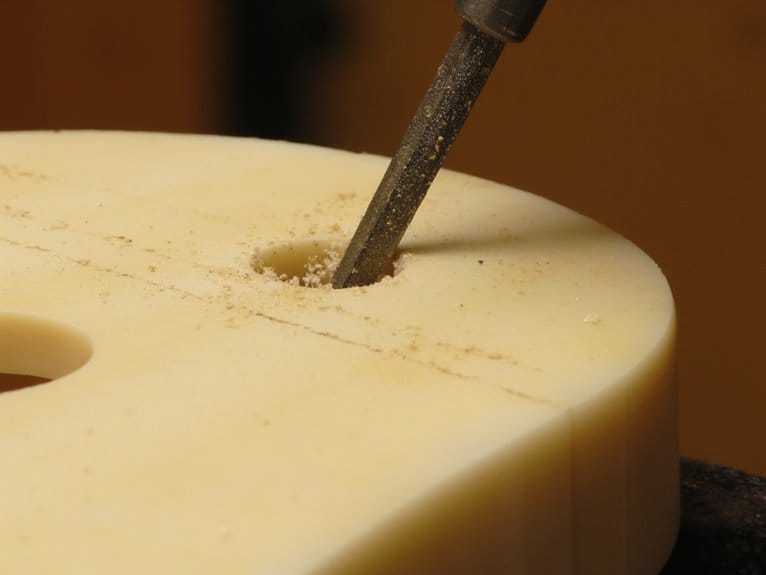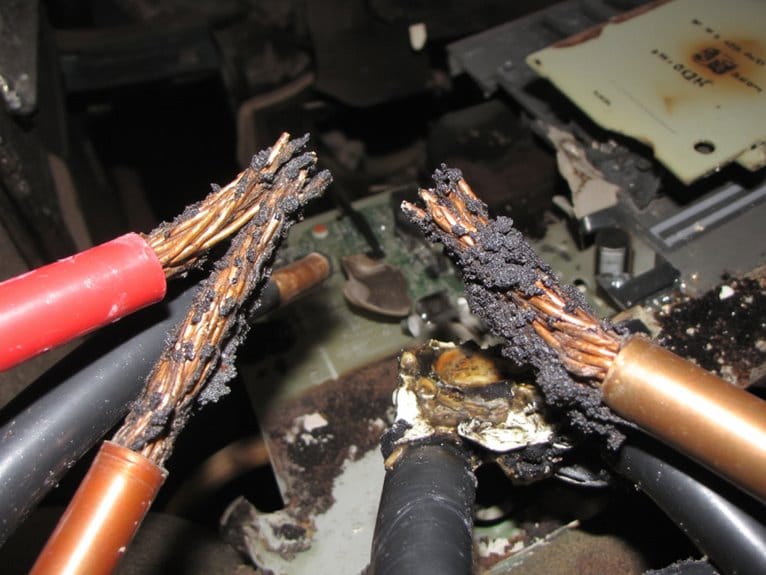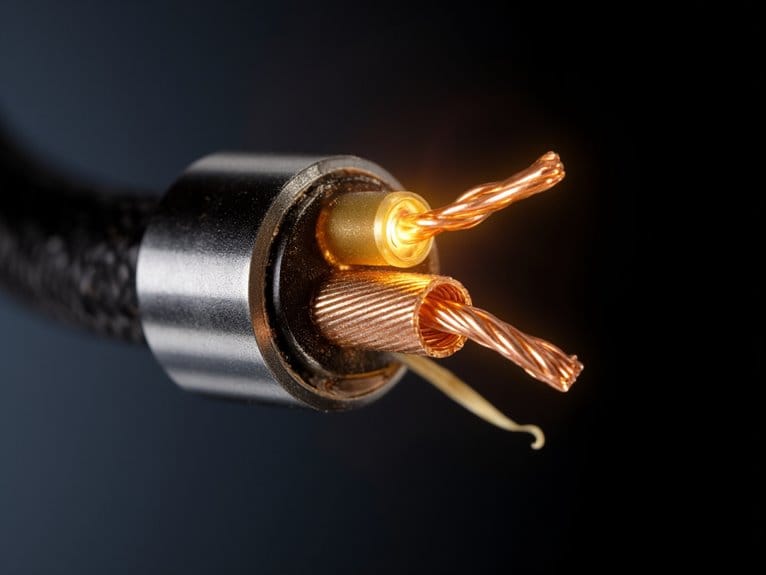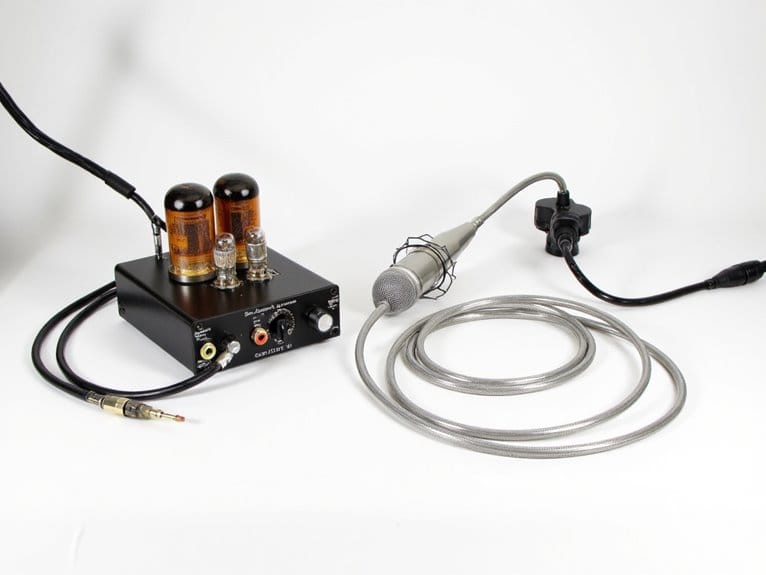Nut Slot Cutting: Critical Measurements
When cutting nut slots, you’ll need 0.018″ clearance for plain strings and 0.02″ for wound strings, with lighter strings sitting level with the nut’s top surface. I’ve learned that matching file size to string diameter plus 0.003″-0.005″ clearance prevents buzzing while maintaining smooth tuning, and positioning outer strings about 4/64″ from fretboard edges guarantees proper spacing. The remaining techniques below will help you achieve professional-level precision.
We are supported by our audience. When you purchase through links on our site, we may earn an affiliate commission, at no extra cost for you. Learn more.
Notable Insights
- Target clearance should be 0.018″ for plain strings and 0.02″ for wound strings to ensure proper playability.
- Match file size to string diameter plus 0.003″ to 0.005″ clearance for optimal slot width and tuning stability.
- Position outer strings approximately 4/64 inch from fretboard bevel with proportional spacing for remaining strings.
- Use precision calipers and nut slot gauges to accurately measure depth and verify proper string clearance.
- Coordinate nut height with slot depth, using shims during testing to prevent permanent over-cutting mistakes.
Determining Proper Nut Slot Depth for Optimal String Action
When I first started cutting nut slots years ago, I’d often rush straight into filing without fully understanding how critical proper depth is for achieving that perfect balance between playability and tone.
Rushing into nut slot filing without understanding proper depth is a costly mistake that compromises both playability and tone quality.
You’ll need to target specific clearances: approximately 0.018″ between the string bottom and first fret for plain strings, while wound strings require about 0.02″ for ideal nut action.
I’ve learned that lighter strings from high E to G should sit level with the nut’s top surface, preventing excessive depth that compromises buzz prevention.
Always start conservatively since cutting too deep means replacing the entire nut, which I’ve unfortunately experienced firsthand when being overly aggressive with initial cuts.
The quality of your nut material significantly impacts how precisely you can achieve these measurements, with bone and graphite options providing superior durability during the cutting process compared to standard plastic nuts.
Selecting the Correct File Size for Each String Gauge
After establishing the correct depth for your nut slots, you’ll discover that selecting the proper file size becomes equally important for achieving clean, buzz-free performance without binding issues. File gauge considerations involve matching your file to each string’s diameter, typically adding .003″ to .005″ for ideal clearance. String type implications matter considerably-guitar strings work best with files .003″ to .004″ larger, while bass strings accommodate up to .005″ oversizing.
| String Gauge | File Size | String Type |
|---|---|---|
| .011″-.016″ | .013″-.018″ | Light Guitar |
| .020″-.054″ | +.003″-.004″ | Medium/Heavy Guitar |
| .080″+ | +.005″ | Bass |
I’ve learned that conservative sizing prevents buzzing while ensuring strings seat properly without binding during tuning adjustments.
String Spacing and Slot Positioning Fundamentals
Everything about your guitar’s playability hinges on getting string spacing right at the nut, and I’ve found that most builders underestimate how dramatically proper slot positioning affects both comfort and performance.
You’ll want to use proportional spacing that accounts for each string diameter, creating equal edge-to-edge gaps rather than center-to-center measurements. I position outer strings approximately 4/64 inch from the fretboard bevel, ensuring consistent edge alignment across the neck width.
Your inner strings need progressive spacing based on diameter increments, not uniform distances. Use precision calipers and specialized rulers to mark each slot position accurately, because even minor errors will cause string buzz, tuning instability, and uncomfortable fretting action that’ll frustrate players. Online string spacing calculators provide edge-to-edge measurements that eliminate guesswork and deliver professional results every time.
Essential Tools and Cutting Techniques for Precision Work
Three specialized file types form the foundation of professional nut slotting work, and I’ve learned that investing in quality cutting tools saves countless hours of frustration while delivering consistently superior results. DiamondCut™ nut slotting files provide exceptional durability for clean cuts, while needle files handle fine-tuning and chamfering operations that prevent string binding. Slitting files with acute edges excel at initial rough cuts and minor adjustments.
| Tool Type | Primary Function |
|---|---|
| DiamondCut™ Files | Clean precision cuts in hard materials |
| Needle Files | Fine-tuning width and edge chamfering |
| Slitting Files | Initial rough cuts and adjustments |
| Nut Slot Gauges | Depth measurement and verification |
Progressive slot deepening techniques, combined with proper file maintenance and thoughtful material selection, guarantee you’ll achieve professional-grade results while avoiding costly mistakes that require complete nut replacement.
Balancing Nut Height With Slot Depth Requirements
When I first started working on guitar setups, I didn’t realize how essential the relationship between nut height and slot depth would become to achieving that perfect balance of playability and tone.
You’ll find that ideal nut adjustments require careful coordination between these measurements, as lowering your nut height typically demands deeper slots to maintain proper string clearance. Nut material considerations also play an essential role, since softer materials like bone compress differently than synthetic alternatives under string tension.
- Start with shallow slots (.010″) and deepen incrementally using feeler gauges as depth stops
- Match slot width to string gauge plus 0.003″-0.005″ clearance for smooth tuning
- Test string action at the first fret after each adjustment to prevent buzz
- Use shims under the nut before filing the bottom to avoid permanent height reduction
- Balance slot depth with nut height to maintain structural integrity while achieving comfortable action
On a final note
You’ve now got the essential measurements and techniques needed to cut precise nut slots that’ll dramatically improve your guitar’s playability. Remember, you can’t rush this process-I’ve learned that patience with filing and frequent string testing saves you from costly mistakes. Take your time with each slot, check your work constantly, and don’t hesitate to make micro-adjustments. Your fingers will thank you when that action feels just right.







